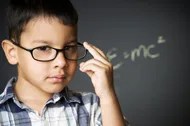It is important for children to develop equal vision in both eyes so that they can succeed in school, sports and other activities that require clear vision, eye-hand coordination, and strong depth perception. Lazy eye is a preventable form of vision loss and is easily treatable in its early stages. If left untreated, it can limit with career choices, and may leave sufferers at higher risk for sight-threatening injury to the better eye. Following is more information about this condition.

What is lazy eye?
Lazy eye, technically known as amblyopia, occurs when a healthy eye does not develop normal sight during childhood. The eye has blurred vision, even with glasses. Amblyopia is not an eye turn, which is known as strabismus. These two conditions may be seen together, but amblyopia is often present without strabismus.
What causes lazy eye?
The most common cause is when there is a significant difference in prescription between the two eyes and it is not corrected with glasses. One eye may have a low — or no — prescription, while the other eye has a much higher prescription. The brain ignores the eye with the larger prescription because all it ‘sees’ is a blur and it is too hard to focus. Eventually, vision stops developing in this eye. Sometimes, the eye then begins to turn.
How common is lazy eye?
Amblyopia is the most common cause of visual impairment in children. Three out of 100 children have lazy eye, though half go undetected. Sadly, as many as one third of children who receive a late diagnosis had already passed preschool vision screenings. Parents should realize that vision screenings cannot replace vision examination. All children should receive a comprehensive eye examination with an eye doctor.
At what ages should children have comprehensive eye examinations?
A child’s first eye examination with an eye doctor should occur at 6-9 months of age. The next eye exam should be between two and three years of age, since many children develop lazy eye and/or an eye turn at this stage. Children should have another exam before beginning school and then every year thereafter. According to the National Center for Health Statistics, 20-25 percent of children enter school with significant vision problems that can affect their development and progress in school.
How is lazy eye treated?
If a lazy eye is detected, glasses or contact lenses are prescribed, giving the lazy eye an opportunity to improve its sight.
In addition, the better eye is patched for two to six hours a day, so as to force the weaker eye to work. For at least an hour of that time, it is important to do visually demanding tasks.
Vision therapy is also done to maintain improvement in eyesight. This includes activities to exercise gross motor skills, focusing, tracking, scanning and searching.
When is it too late to treat lazy eye?
The visual system is adaptable, and can always be trained to improve eyesight. It is never too late to treat lazy eye.
Dr. Michal Luchins practice is in Suffern. For more info: www.optometrists.org/DrLuchins.





















